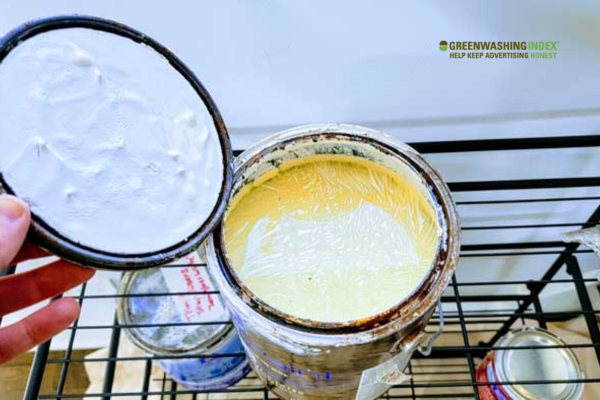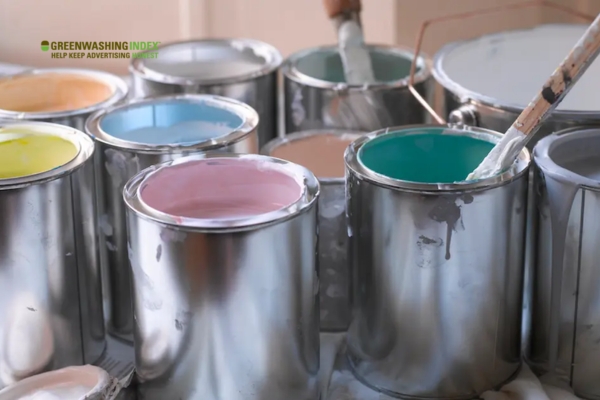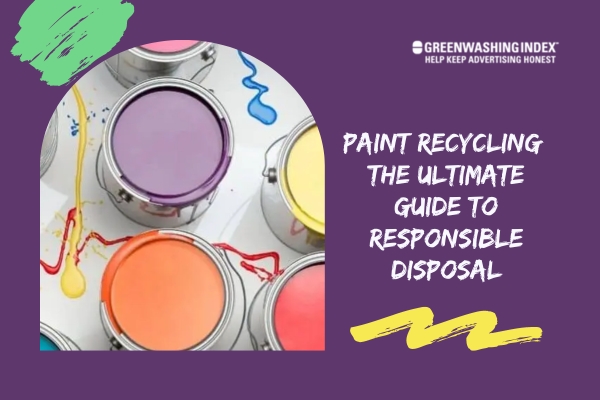Ever felt stuck with old paint cans cluttering your garage or shed, unsure of what to do with them? You’re not alone, but I’ve got some fantastic news for you! This article will walk you through the art of paint recycling, providing you with all the necessary steps from identifying recyclable paints to finding local facilities that’ll take them off your hands.
If tackling environmental issues while giving your space a clean-up sounds good, then learning about paint recycling is perfect for you. Let’s not only make our homes cleaner but also contribute positively to our planet together!
Understanding Paint Recycling
Are you ready to take a step towards a more eco-friendly lifestyle but not sure where to start? Paint recycling is a great way to reduce waste and help the planet. Whether you’re clearing out your garage or just finished a home makeover, you might be wondering what to do with leftover paint. Let’s explore which types of paint can be recycled and why it’s such an important task.
Types of Paint Suitable for Recycling
When it comes to recycling paint, not all types are treated equally. Here’s a breakdown:
- Latex Paint: This water-based paint is the most commonly recycled type. It’s easier to handle and less hazardous than its counterparts.
- Oil-Based Paint: Although recyclable, oil-based paints require special handling due to their flammable nature and toxic ingredients.
- Acrylic Paints: Similar to latex, these water-based paints are also recyclable.
What Can’t Be Recycled?
- Paint Cans that are empty or have dried paint residue
- Aerosol Spray Paints
For successful paint recycling, follow these steps:
- Check if the paint is liquid: Only liquid form paints can undergo the recycling process.
- Ensure there are no contaminants: Mixed or dirty paints might not be accepted for recycling.
Understanding which paints you can recycle helps in sorting your materials correctly and ensuring they find their new purpose efficiently.
The Importance of Paint Recycling
Recycling paint does more than just clean up your storage areas; it has significant environmental impacts.
Why Recycle Paint?
- Conserves Resources: Recycled paint uses fewer resources than producing new cans of paint from scratch.
- Reduces Hazardous Waste: By recycling, we cut down on harmful waste ending up in landfills where it can leak toxic substances into soil and waterways.
- Lowers Greenhouse Gas Emissions: Producing new products from recycled materials generally requires less energy, resulting in lower emissions contributing to climate change.
- Promotes Sustainable Living: It sends a strong message about valuing resources and supports sustainability initiatives.
By understanding both what kinds of paints can go back into circulation through receding channels and why doing so is crucial for our environment underscores our collective role in fostering sustainable habits for future generations.
Also Read: Master Smell-Free Apartment Composting: An Ultimate Guide
Preparing Paint for Recycling
Getting ready to recycle paint is easier than you think, and it all starts right in your garage or storage area. Have you ever looked at your old paint cans and wondered, “Can these be recycled?” Well, the answer is yes! But first, we need to get them ready. Sorting and organizing paints is your first step—it’ll help you figure out what can go where.

Then, packing them up safely makes sure they’re ready for their next journey. Let’s walk through how to get your paints sorted and packed with the environment in mind.
Sorting and Organizing Your Paints
Sorting out which paints can be recycled is like treasure hunting in your own home. Here’s how to ace it:
- Know What You’re Dealing With: Identify if your paint is latex (water-based) or oil-based. Latex paint is recyclable more often than oil-based.
- Check the Condition: Only liquid paint can be recycled. Hardened or completely dried-out paint isn’t accepted by most recycling programs.
- Separate by Type: Keep latex paints together and away from oil-based ones since they are processed differently.
- Read the Labels: Not sure about the type? The label usually tells you if it’s water or oil-based.
- Inspect for Contamination: Paint that’s mixed with chemicals or other substances isn’t suited for recycling.
By dividing your stash correctly, not only have you made a big leap towards helping our planet, but you’ve also simplified what comes next—packing them up right!
Packaging and Storage Guidelines
Once sorted, ensuring your paint is stored and packaged properly will keep things safe until they’re recycled:
- Keep Lids Tight: Make sure all containers are closed securely; this prevents leaks during transportation.
- Don’t Combine Colors: While it might save space, mixing different colors or types can make the batch useless for recycling.
- Use Clear Labeling: Label each can with its type (latex or oil) to help facilities process them faster.
- Pack Lightly: Don’t over-pack boxes; ensure there’s enough room so cans don’t get crushed but remain upright during transit. 5 .Mind Temperature Extremes: Store in a cool, dry place before dropping off; extreme cold or heat can spoil the batch.
Adhering strictly to these steps means that not only are you doing good by recycling but also ensuring that the process goes smoothly from start to finish without causing any unnecessary messes along the way.
Ready? Set? Recycle!
Also Read: Tupperware Recycling: Can You Really Recycle Them?
Finding Paint Recycling Facilities
When you’ve finished your latest home project and find yourself staring at cans of leftover paint, knowing how to properly dispose of or recycle them is key. Don’t let those old paint cans clutter up your garage or harm the environment. Discovering where to recycle paint and engage with community efforts makes a big difference.
We’ll guide you through the process of finding local recycling options for your unused paint and show you how becoming part of a community take-back program can not only clear up your space but also help the planet.
Local Options for Paint Recycling
Finding a place to recycle your unwanted paint has never been easier, thanks to several resources available at our fingertips. Here’s how you can locate facilities that accept paint for recycling and some tips on using online tools effectively:
- Check with Local Government Websites: Start by visiting your city or county’s official website. Most have specific sections dedicated to waste management or recycling information where they list acceptable materials and drop-off location details.
- Use Specialized Online Directories: There are websites designed specifically for helping people find their nearest recycling centers, including those that accept different types of paint. Earth911.com is one well-known example where you can simply enter your ZIP code and the type of material (in this case, “paint”) to get a comprehensive list of local facilities.
- Home Improvement Stores: Some large chains offer take-back programs for paints as part of their commitment to environmental sustainability. Checking with stores in your area might uncover convenient drop-off points right where you buy new paint.
- Reach Out via Social Media or Community Boards: Often, locals will share valuable insights on lesser-known donation centers or organizations that run periodic paint collection drives not listed elsewhere.
Remember, before taking your paints anywhere, confirm they accept the type(s) of paint you’re looking to recycle since not all facilities can process every kind.
Participating in Community Paint Take-Back Programs
Being part of a community-driven solution amplifies the positive impact we can have on our environment. Paint take-back programs are an excellent way for individuals and communities together to ensure responsible disposal and recycling of unused paints. Here are details on engaging with these programs:
- Find out about upcoming events: Many communities organize special collection events aimed at collecting hazardous waste including all types of paints. Keep an eye on local bulletin boards, community websites, or social media groups dedicated to sustainability efforts in your area.
- Local Hazardous Waste Programs: Communities often run ongoing hazardous waste programs which also accept paints along with other materials like batteries and electronics. Contacting these programs directly gives insight into when they’re open for drop-offs.
- Engage With Environmental Nonprofits: Organizations focused on environmental protection sometimes host collaborative events with municipalities for collecting non-discardable items including paints.See if such NGOs operate within reach by doing a quick online search or networking within eco-friendly circles.
Getting involved requires small steps like marking calendar dates for collection events ahead of time or even volunteering during these activities if possible. Displaying proactive behavior amplifies awareness around us encouraging more people to choose sustainable options over easy disposal. Success stories from engaged communities often inspire others miles away proving collective efforts go a long way in making real differences.
Also Read: Plastic Bag Recycling: Easy Steps for a Clean Planet
The Process of Paint Recycling
Ever wondered what happens to paint once it’s out of your hands and on its way to being recycled? Well, the journey from old paint cans in your garage to shiny, repurposed products is both fascinating and full of potential for eco-friendly innovation.

Let’s walk through how paint undergoes transformation through recycling, and get ready to be inspired by the imaginative ways this recycled paint can breathe life into new projects.
How Is Recycled Paint Processed?
The process of recycling paint can vary based on the type (like latex or oil-based), but the steps are generally as follows:
- Collection and Transportation
- First thing’s first: collected paints are transported to a recycling facility. Collection could happen through drop-off centers, special collection events, or pick-up services offered by some localities.
- Sorting
- Upon arrival at the recycling center, paints are sorted into types because different types require different processing methods. Usability is assessed; partially dried or contaminated paints might have a separate fate such as proper disposal rather than being recycled.
- Manual Checking
- Next comes manual checking where workers inspect each can more closely for contaminants like dirt or unusual substances that didn’t get caught during sorting.
- Opening and Emptying
- Each suitable can is then opened, and its contents are emptied into a large mixing vat. Similar colors might be mixed together to create standard hues which helps in producing consistent recycled product colors.
- Processing
- This step varies significantly depending on whether the paint is latex-based or oil-based:
- For latex paints, they go through filtration to remove any impurities followed by adjustments in pH levels if necessary.
- Oil-based paints often undergo distillation where they’re heated so components can separate based on boiling points for further uses.
- This step varies significantly depending on whether the paint is latex-based or oil-based:
- Additives
- New additives might be introduced at this stage to improve color match consistency across batches, prolong shelf life, or enhance performance in various weather conditions for exterior applications.
- Repackaging
- Finally, once everything looks good—meaning it’s passed quality control tests—the recycled paint is packed up into new containers ready for its second life.
Innovative Uses for Recycled Paint
Recycling doesn’t end with turning old housepaint into new; innovative projects around the world have found creative applications for this resource:
- Public Space Beautification:
- Parks, playgrounds, and community centers often benefit from donations of recycled paint helping transform spaces with fresh coats that invigorate communal areas.
- Affordable Housing Projects:
- Non-profits building homes for those in need use recycled paint not only as an economic choice but also as an environmentally responsible one.
- Artistic Endeavors:
- Artists experiment with recycled paint as a medium understanding its unique composition adds depth and texture different from virgin materials providing exclusive finishes unattainable elsewhere.
- Product Manufacturing: – Some entrepreneurial efforts turn recycled latex back into raw material used in creating new products ranging from rubberized mats to lining materials demonstrating circular economy concepts firsthand.
In essence, paint recycling unfolds through meticulous steps ensuring unwanted leftovers transform responsibly while pioneering initiatives to find remarkable means to repurpose this colorful resource into impactful contributions across communities.
Also Read: DIY Face Masks: Your Guide to Eco-Friendly Creations
DIY Projects with Leftover Paint
Do you have some leftover paint from your last room makeover and no idea what to do with it? Well, you’re in luck! We’re about to show you how those old paint cans can breathe new life into your home and create stunning pieces that will make your friends green with envy.

From turning your walls into a masterpiece of art to ensuring you stay safe while getting creative, we’ve got all the tips and tricks you need.
Creative Ideas for Using Up Leftover Paint
When it comes to using up leftover paint, the possibilities are as wide as your imagination stretches. Here are a bunch of ways to turn that extra paint into something beautiful:
- Wall Murals: Forget plain walls; why not try your hand at painting a mural? Choose a wall in need of some love and sketch out a design. Whether it’s an abstract splash of color or a detailed scene, murals can totally change the look of a room.
- Furniture Makeover: Give old furniture pieces a new lease on life with some paint. From chairs that need cheering up to tables crying out for color, just brush on some leftover paint for an instant refresh.
- Plant Pots: Brighten up your garden or indoor plant display by painting terracotta pots. Vibrant colors can make even the simplest plants pop, and patterns add fun details.
- Custom Artwork: Canvas art isn’t just for professional artists; grab some canvases from the craft store and make your own! Whether it’s large strokes of color or something more intricate, these homemade artworks can be real conversation starters.
- Accent Pieces: Small items like picture frames, lamp bases, or shelving units can become statement pieces with just a dab of paint – perfect for adding character to any room without committing to big projects.
- Backsplash Patterns: Refreshing your kitchen doesn’t have to mean an entire remodel; use leftover paints on tiles (make sure they’re properly primed) for bespoke designs that spice up any cooking space.
- Door Edges Pop: Painting the edge of doors in bright colors adds an unexpected surprise when you open them – simple but effective for adding intrigue indoors!
Safety Tips When Handling Old or Unused Paint
Working with old or unused paint requires care – both for our health and environment’s sake! Here are essential safety tips:
- Wear Protective Gear: Always wear gloves and possibly even goggles when dealing with older paints, especially if they might contain lead or other harmful substances.
- Good Ventilation is Key: Ensure working areas are well-ventilated since fumes from certain paints can be harmful over time.
- Check Before Use: Before using older paints, inspect them carefully; if there is any sign of mold growth inside the tin do not use as this could lead to health issues.
- Dispose of Responsibly: Any unused paint should never go down drains or in household trash bins due their potential harm on the environment – check local recycling options instead.
- Keep Away from Heat Sources: Store any ongoing project materials away from heat sources such as radiators and direct sunlight locations – fire risks are real concerns!
By following these creative ideas and safety precautions closely everyone can enjoy transforming spaces around themselves safely while putting leftover paints to good use – happy painting!
Conclusion
Recycling paint is a smart step towards helping our planet. By reusing or properly disposing of unwanted paint, we cut down on waste and give old materials new life. It’s easy once you know how, and anyone can get involved.
If you’re ready to clear out your old paint cans while being kind to the earth, try recycling your paint today. It’s a small action with a big impact on our environment. Ready to become more eco-friendly? Dive into more of our simple and effective sustainability tips and tricks.



